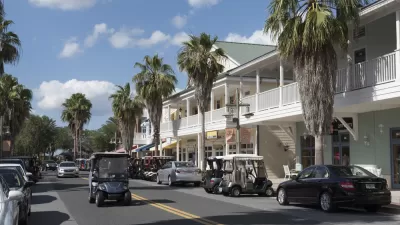Joel Kotkin and Alan M. Berger discuss their new book, which analyses what the suburbs are and will become, in both the United States and around the world.

A new book, Infinite Suburbia, edited by Joel Kotkin and Alan M. Berger, looks at suburbia from a variety of perspectives. At more than 700 pages, it is a collection of essays from the perspectives of architecture, planning, history, and transportation, to name a few. The Architect's Newspaper interviewed Kotkin and Berger about it.
In the interview, Kotkin is quoted:
"Two trends that may seem counterintuitive to urbanists have been the rapid pattern of diversification in suburbs, which now hold most of the nation’s immigrants and minorities, as well as the fact that suburbs are more egalitarian and less divided by class than core cities."
Kotkin and Berger point out that suburbs are not just diversifying, but that many U.S. central cities exhibit suburban land use patterns. Conversely, many cities around the world have suburbs with housing that is primarily multifamily and dense, a far cry from the transitional American single-family home and manicured lawn.
They point out that the future of suburbs will continue to be denser, but also more environmentally friendly. Suburbanites will demand fewer golf courses in the future and more public trails and common landscapes. They also believe autonomous cars will transform suburbia, and take strain off of transit systems so they can focus on improving service in urban cores rather than expanding outward in less efficient ways.
FULL STORY: What if Everything You Know About the Suburbs is Wrong?

Alabama: Trump Terminates Settlements for Black Communities Harmed By Raw Sewage
Trump deemed the landmark civil rights agreement “illegal DEI and environmental justice policy.”

Planetizen Federal Action Tracker
A weekly monitor of how Trump’s orders and actions are impacting planners and planning in America.

Why Should We Subsidize Public Transportation?
Many public transit agencies face financial stress due to rising costs, declining fare revenue, and declining subsidies. Transit advocates must provide a strong business case for increasing public transit funding.

Understanding Road Diets
An explainer from Momentum highlights the advantages of reducing vehicle lanes in favor of more bike, transit, and pedestrian infrastructure.

New California Law Regulates Warehouse Pollution
A new law tightens building and emissions regulations for large distribution warehouses to mitigate air pollution and traffic in surrounding communities.

Phoenix Announces Opening Date for Light Rail Extension
The South Central extension will connect South Phoenix to downtown and other major hubs starting on June 7.
Urban Design for Planners 1: Software Tools
This six-course series explores essential urban design concepts using open source software and equips planners with the tools they need to participate fully in the urban design process.
Planning for Universal Design
Learn the tools for implementing Universal Design in planning regulations.
Caltrans
Smith Gee Studio
Institute for Housing and Urban Development Studies (IHS)
City of Grandview
Harvard GSD Executive Education
Toledo-Lucas County Plan Commissions
Salt Lake City
NYU Wagner Graduate School of Public Service





























